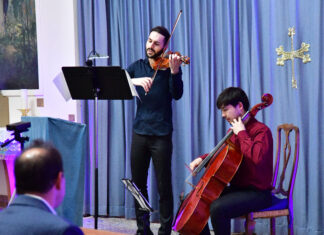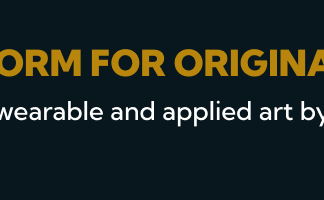NEW YORK — While the Atamian Hovsepian Curatorial Practice (AHCP) is new on the scene, it has been able to carve out an important niche in the city’s art world. The space is a non-profit dedicated to exhibiting some of the best in contemporary art, particularly by what the curators Christopher Atamian and Tamar Hovsepian term underrepresented groups that include: people of color, women, Southwest Asian and North African artists, particularly Armenians: “Go to any major museum today and count the number of women in the permanent collections — I doubt you will find more than 10 percent. As for Armenians, there may be one in each collection, say a Gorky for example, at the Whitney. In this day and age, that is inexcusable.” AHCP wants to help identify, exhibit, and place these artists in collections worldwide,” they said.

On May 11, AHCP held a benefit opening.
As a non-profit all works in the gallery are for sale and the funds will go directly to the organization to mount future exhibitions. The practice was founded in 2022 by two colleagues with extensive experience in the art world, Christopher Atamian and Tamar Hovsepian.
Their first exhibition, in a Chelsea pop up space, was titled “The Future of Things Past,” and featured four women artists and received critical praise and more than 1,000 visitors over the course of three weeks. They followed this up by curating “Art to Learn, Art to Live,” a show of 53 of Lebanon’s leading contemporary artists at Lebanese American University’s midtown campus.
The gallery currently has three exhibitions up simultaneously, all of them impressive in their own right. Yerevan-based Arpi Adamyan’s immersive installation piece, “The City of Dove Women,” captivated visitors. Two TV screens lie flat on a table three feet off the air, as a video plays with narration describing an underwater world, telling the story of Dove women and placenta jellyfish. Atop the screens are “islands” of enticing multicolored porcelain objects, reminiscent of human body parts. The installation’s title is derived from an Armenian fairy tale “Aregnazan,” in which a young girl changes gender and eventually weds the King’s daughter, Nenuphar. It touches on issues of identity, the environment and building a more natural and equitable society — all themes important to the concept of Armeno-Futurism.

In another large gallery room visitors can discover New York City-based artist James Gortner’s “reclaimed paintings,” which take abstraction to a new level. While he has in the past made figurative paintings, here he reclaims layers of paint from surfaces once touched by other artists and stories, onto his canvas becoming a translator and a storyteller that redefines transference, communication and connectivity. The show’s title, Terra Incognita, refers to the incredible colored maps formed by these reclaimed materials, which transform them into something wholly new. Each viewer sees different outlines, formations, and shapes–newly created topographies. This innovative work belongs at the forefront of the Enviro-Futurism movement which tries to point the way to a world where technology respects nature and improves the world for all involved.









